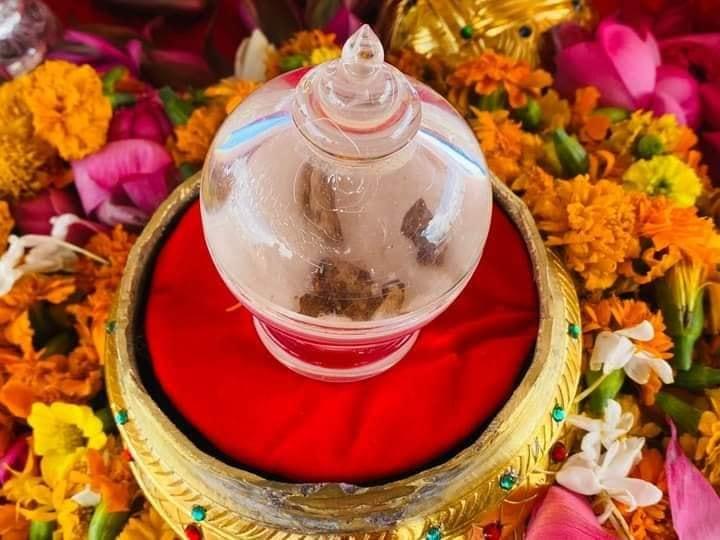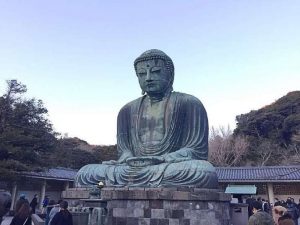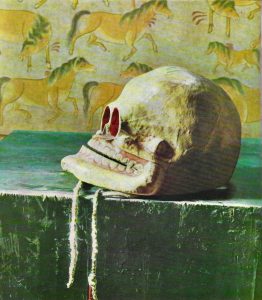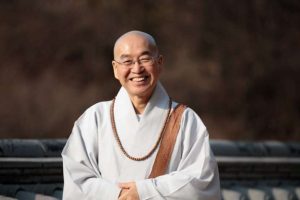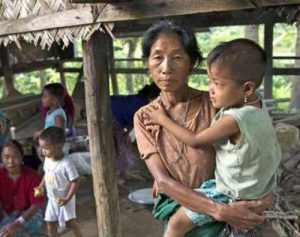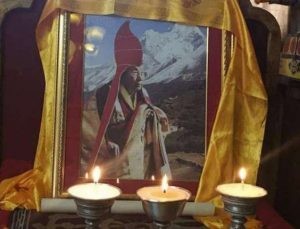The Anula Stupa at Mihintale, Sri Lanka, is popularly known these days as Anula Devi Cetiya and is recorded in inscriptions as the Anula Tissa Stupa. It would seem to be one of the many Buddhist ruins scattered across South and Southeast Asia, however, the story of the Anula Cetiya’s importance and surrounding archeological mysteries is a tale worthy of a Dan Brown novel. This site, unlike the Louvre, actually is the only known site in the world that attests to and contains, unambiguously, the relics of an ancient Buddhist country’s first female monastic. She was the first bhikkhuni known, outside of India, to attain full enlightenment as an arahat, or in the feminine form: arahati.
Sri Lankans, and many Theravada Buddhists around the world, are familiar with Sanghamitta Theri, who entered parinibbana in 203 BCE. However, until now, mostly only Sri Lankans have been familiar with her leading disciple, the first Sri Lankan bhikkhuni Anula Theri, who lived in the second century BCE. Sanghamitta was the daughter of Ashoka the Great, a former princess who brought Buddhism to the island alongside her brother Mahinda Thero, and established the first ancient monastic order of women in Sri Lanka, where it is known as the bhikkhuni sasana.
Sanghamitta’s name is inseparable in Sri Lanka from the name of Anula Devi, later Anula Theri. She was the native chief queen of the then-King Devanampiyatissa’s younger brother Yuvaraja Mahanaga, the viceroy and crown prince of Lanka and Prince of Ruhuna (Rohana). Queen Anula converted to Buddhism after “opening the Dhamma eye.” She became a stream-enterer and then stream-winner while listening to Mahinda Thero’s teaching, a few months later becoming the first Sri Lankan bhikkhuni. She ordained with Sanghamitta, becoming the first in a lineage of more than a thousand recorded female arahats of the third century BCE on the isle of Lanka.
Discoveries of 24 December 2022 at Anula Cetiya now place this ancient sacred Buddhist site in a unique category: the only intact stupa clearly dedicated to one of the ancient bhikkhuni arahats and where sacred bodily relics (saririka dhatu) are still known to exist intact onsite. In other words, this sacred place contains physical relics as well as inscriptional attestation to the life of one of the ancient great bhikkhuni arahats—great and fully enlightened female disciples of the Buddha recorded in early Buddhist texts. In this case, these are the Pali text chronicles of Sri Lanka.
No other early Buddhist female arahat’s stupa has been definitively located in this way: confirmed by inscriptions and with relics known to be present. Not even Mahapajapati Gotami’s Parinibbana Stupa in Vaishali, India, enjoys this status. Mahapajapati Gotami’s stupa was visited and recorded by monastic pilgrims of yore such as Xuanzang before being lost. It was only recently tentatively relocated, based on the famously accurate directions left in Xuanzang’s pilgrimage diary. The Sanghamitta Stupa near Mihintale, in the sacred city of Anuradhapura, might be considered an exception. Still, while its location is recorded in the ancient chronicles, there is no onsite inscription to affirm the connection to Sanghamitta. Although rudimentarily renovated by pious faithful laity and monastics in 2009, the site has yet to be excavated and restored to confirm its attribution.
Knowledge of Anula Theri’s stupa has been confined largely to Sri Lanka, except for a few international bhikkhuni pilgrims. It was not known to still contain intact relics until this year’s excavations. Excavations and restoration work were launched late last year on Sanghamitta Day (26 December 2021), in the presence of more than 2,000 bhikkhunis from around the island.
Stone inscriptions at the Anula Cetiya site, translated in 1926 (the year the area was designated an archeological site), offer a clear and unambiguous attribution indicating the ancient stupa as the location of the ordination, residence, and Tipitaka study and teaching arama of Anula Theri and 500 members of the earliest Sri Lankan bhikkhuni sangha. The inscriptions also reveal the famed second century BCE Sri Lankan Queen Mother Viharamahadevi, mother of Anuradhapura King Dutthagamini, as the donor who constructed and established the stupa. However, the unguarded stupa was broken into and plundered by thieves, and over the years overgrown by bushes and trees. To protect from further pillaging, the stupa and grounds, which contain further ancient stone ruins of monastery buildings, water channeling works, and stone inscriptions, were declaredin June of 2008, by government gazette, as a protected archeological monument.
The excavations launched in December 2021 by the Archeology Department of of Sri Lanka, in partnership with Mihintale Rajamaha Vihara and Nagananda University, under the direction and supervision of the Department of Archeology, were aimed at restoration. It was not known whether any relics remained in the stupa after its earlier plundering. However, throughout 2022, sacred Buddhist relics and antiquities progressively began emerging from the stupa: first, higher up, in a crystal casket, were relics attributed by inscription to the Buddha himself. Later, lower down, in a stone manjusa container, were further relics, perhaps of Sanghamitta Theri.
Finally, revealed on 24 December was a great cache of more than 500 relics, entombed in the garbha, “womb” or very heart of the stupa. This included many forms of jewelry (rings, bangles, and beads) offered and enshrined together with the principle sacred relics, and are understood to be those of Anula Theri. From the example of the stupas of Sanchi, enshrining a small portion of the Buddha’s relics above the bodily remains of his arahant disciples was a reverential custom of the Ashokan era of Early Buddhism, which was transmitted from the Sanchi area, the maternal home area of Mahinda Thero and Sanghamitta Theri, to Sri Lanka. Mihintale Raja Maha Vihara prefect Ven. Dr. Walawahengunuwewa Dhammarathana Thero and Nagananda University Chancellor Ven. Dr. Bodagama Chandima Thero were the senior monastics jointly initiating, leading, and supporting this excavation and restoration.
On 25 December, Sri Lankan news platform Lankadeepa and other news outlets began reporting that relics attributed variously to “Maharhat Anula Theraniya” or Great Arahati Anula Theri after 12 months of excavation had been exhumed on the previous day. The announcement was made and a news conference held after the outstanding discovery was reviewed and examined by Department of Archeology director-general Anura Manatunga and Anuradhapura District excavation officer A. A. Wijayaratne.
Ven. Bhikkhuni Tathaloka Mahatheri, whose graduate school studies in Buddhism were in World Bhikkhuni Sangha History, serves as the coordinator of Bhikkhuni History/Herstory & Heritage for United Theravada Bhikkhuni Sangha International (UTBSI). She has been interested in the Anula Devi Cetiya for years and recollects first reading about it 20 years ago. The news was reported in English in the early 21st century by the first Thai bhikkhuni, Ven. Dhammananda Theri, and the first American bhikkhuni to ordain in Sri Lanka, Ven. Sudhamma Theri. Both received higher ordination in Sri Lanka in 2003 and afterwards visited the Mihintale Anula Stupa ruins on a post-ordination pilgrimage.
Ven. Tathaloka frequently visited the cetiya ruins herself between 2017 and 2019, prior to the initiation of the excavation and restoration, interviewing the local Mihintale archeology department head on the stupa’s history in late 2018. She shared with BDG relevant Sinhalese reporting to reveal the significance of these relics for the worldwide sangha:
[On 26 December 2022] The Director General of Archeology opened for public exhibition the venerable relics (dhātu), jewels and other precious items of historical archaeological value found during the excavations of Anulā Cetiya, introducing the Bhikkhuni Sāsana to the whole world.
Ven. Dr. Walawahengunuwewa Dhammarathana Thero, abbot of Mihintala Raja Maha Vihara, said that the place has been opened today (Dec 26th 2022) for the devotees living in every place in Sri Lanka to see and venerate it.
During the excavations carried out by the archeological officers for the past several months, many different types of items have been found in which crystal caskets, stone mañjusa, ornaments (bangles, rings), various types of beads, and the like were kept, together with the holy relics (dhātu). . . . all the crystal reliquary containers were kept in a very secure chamber that was constructed near Anulā Cetiya, where they were placed for public display.
The cultural relics and heritage properties were inspected on-site at the Anulā Cetiya by Archeology Director General Senior Professor Anura Manatunga who came to Mihintale to do so, together with Anuradhapura District Excavation Officer A.A. Wijayaratne, Mihintale Raja Maha Vihara Head Ven. Dr. Walawahengunuwewa Dhammarathana Thero and Nagananda University Chancellor Ven. Dr. Bodagama Chandima, accompanied police officers and military personnel.
(Lankadeepa)

On 26 December, Ven. W. Dhammarathana Thero, the chief prelate for Sri Lankan Buddhists in Taiwan and vice-chancellor of Nagananda Buddhist University, invited 5,000 bhikkhunis, Sri Lankan nationals and internationals alike, to come to Anula Cetiya, together with more than 1,000 members of the bhikkhu sangha and Buddhist laity, to view the relics. The Vietnamese ambassador to Sri Lanka, Ho Thi Tranh Truc, was also in attendance, together with leading mahatheros from around the Island. A great sanghadana was offered to the assembled 5,000 bhikkhunis from around the island on the occasion, in conjunction with the premier viewing of the sacred relics. It was announced that a museum would be built onsite to enshrine the antiquities, and that the sacred relics would be brought on tour around the island in the coming year for the faithful to view (pradarsana, holy darshan).
Tathaloka Theri notes that the stupa (which is interchangeably called a caitya or cetiya, as well as a pagoda, or in Sinhalese, dagoba), was constructed and established by Anula Theri’s next generation royal relative Viharamahadevi, or Queen Mother Savera, who is considered a national heroine in Sri Lanka. Per stone inscriptions, she too in later life entered the monastic order, as did two daughters of her husband the King of Ruhuna (Rohana), who themselves were sisters of the King of Anuradhapura. The thousands of bhikkhunis of that era are recorded by the Dipavamsa as outstanding teachers of the Vinaya Pitaka, as well as the Sutta Pitaka and Abhidhamma. They were highly knowledgable in saddhammavamsakovida, that is, in Buddhist history and herstory. Ven. Tathaloka shared with BDG:
Many are unlikely to know what an enormously important key link Anulā Tissā Therī is in the ancient lineage of the Bhikkhuni Sangha. In mainstream primary education in Thailand for example, most schoolchildren in their basic Buddhism class in grade school, learn that Sanghamitta Theri was the last bhikkhuni, and that after her the women’s Order ceased to exist, coming to an end during the Ashokan period. Clearly, from the perspective of the Sri Lanka Pali chronicles’ position, this is absolutely not true; they clearly record the story of Queen Anulā Devi’s request for ordination, together with a great crowd of 1000 members of her family and royal household, as well as their ordination with Sanghamittā Therī and the bhikkhuni sangha who came from India to Sri Lanka with her; and shortly afterwards, theirs’ and firstly, Anulā Theri’s, full awakening, arahathood.
(Tathaloka Theri)
Some critics have said that these are just texts and as such subject to hyperbole, but as most students of history and archeology learn, epigraphy, alongside numismatics, are among the most reliable forms of historical evidence. In this regard, as Tathaloka Theri notes: “There are numerous later inscriptions of royal donations to bhikkhuni communities in Sri Lanka over a 1,200-year period, up into the 11th century. This is evidence literally ‘written in stone’ of a living and flourishing bhikkhuni tradition from the third century BCE to the 11th century CE. This stands in important contradistinction to contemporary mainstream Theravada traditions that claim, variously, that: the bhikkhuni sangha died out in the Buddha’s lifetime, after the parinibbana of Mahapajapati Gotami and her associates (as commonly taught in southern Thailand); died out after Sanghamitta Theri (as taught in central Thailand); or died out after the first five centuries of the Buddha’s dispensation (as commonly taught in Cambodia).”
The year 2022, from Bhutan to Bangladesh to Bodh Gaya in India, has been remarkable for the global order of female monastics. In the final month and final days of last year, the unearthing of the Anula Cetiya relics in Sri Lanka was like the crowning jewel, revealing the physical presence of the ancient Arahati Anua Theri herself. Maha Arahati Anula Theri’s stupa and the relics emerging from it to the eyes of the world are a sign that the female sangha’s ongoing work to rebuild, restore, and revitalize the early Buddhist vision ever more thoroughly across the globe is a righteous one.
See more
අනුලා දා ගැබෙන් පුරාවස්තු රැසක් හමුවේ (in Sinhala) (Lankadeepa)
අනුලා මහා රහත් තෙරණිය වන්දනා කරන්න මහා සෙනගක් (in Sinhala) (Lankadeepa)
අනුලා මහරහත් තෙරණියගේ ධාතුන් වහන්සේලා හමුවෙයි | මිහින්තලේ හාමුදුරුවන්ගේ රටටම සුබ පණිවිඩයක් (YouTube)
Evidence of historic Buddhist nunnery emerges from Mihintale (Times Online)
Related news from BDG
142 Buddhist Nuns Receive Full Ordination at Landmark Ceremony in Bhutan
Related features from BDG
Buddhistdoor View: New Theravada Bhikkhuni Ordinations a Cause for Joy
Gelongma Dompa (dgeslongma’i sdom pa): The Blessing of Bhikshuni Ordination in Bhutan
Related posts from BDG’s Tea House Blog
A New Era for the Women’s Order: UTBSI’s First International Bhikkhuni Ordination in Bodh Gaya




